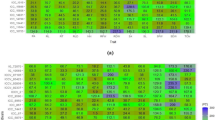Abstract
Five popular but iron-inefficient cultivars were crossed with three efficient genotypes and both parents and F1s were evaluated for iron-efficiency in potted calcareous and noncalcareous soil. The iron-efficient genotypes were dark green or green in both noncalcareous and calcareous soils whereas inefficient types were light green to yellow in calcareous soil. The chlorophyll and active iron (Fe2+) concentration of leaves was less in iron-efficient genotypes compared to efficient types in calcareous soil and reduction of both the parameters from noncalcareous to calcareous soil was considerably high in iron-inefficient lines. There was significant correlation between visual scores, chlorophyll and active iron content. There were no differences among F1s for iron chlorosis and they were all iron-inefficient. The frequency of iron-inefficient plants was higher than the efficient plants in all F2 populations. But most of the productive plants came from iron-efficient segregants indicating strong association between iron-efficiency and productivity. Based on the results selection for iron-efficiency in early generations and extensive evaluation for productivity in advanced generations is suggested for developing varieties for cultivation in calcareous soils.
Similar content being viewed by others
References
Anonymous 1989 An assessment of yield losses in groundnut caused by yellowing. Proceedings of XXXV Annual Rabi oil seed Workshop held at Tamilnadu. p 1. Agricultural University, Coimbatore, India.
Fehr W R, Vose B K and Cianzio S R 1984 Registration of a germplasm line of soybean A 7. Crop Sci. 24, 390–391.
Gopalkrishnan S and Shrinivasan P S 1976 Chlorotic phenomenon in groundnut. Madras Agric. J. 63, 219–223.
Gowda M V C, Kulkarni V N, Nadaf H L and Nadaf S K 1993 Inheritance of iron absorpiton effciency in groundnut (Arachis hypogeae L.). Crop Improvement Ludhiana 20, 197–200.
Habib A F and Joshi M S 1982 Combating iron chlorosis in soils of Malaprabha and Ghataprabha area. Curr. Res. U AS Bangalore 11, 51–54.
Hartzook A, Karstad D, Naves M and Fieldman S 1974 Differential iron absorption effciency of Peanut (Arachis hypogaea L.) cultivars grown on calcareous soils. Agron. J. 66, 114.
Jesson H J, Dragounuk M B, Hintz R W and Fehr W R 1988 Alternative breeding stragegies for improvement of iron efficiency in soybean. J. Plant Nutr. 1, 717–729.
Katyal J C and Sharma B D 1980 A new technique of plant analysis to resolve iron-chlorosis. Plant and Soil 55, 105–119.
Kulkarni V N, Gowda M V C, Panchal Y C and Nadaf H L 1994 Evaluation of groundnut cultivars for iron absorption efficiency. Crop Res. Hisar. 7, 84–92.
Lindsay W L and Norvel W A 1978 Development of DTPA. Soil test for zinc, iron, manganese and copper. Soil Sci. Am. J. 42, 421–428.
Yoshida S Forno D A Cock J H and Gomez K A 1976 Laboratory manual for physiological studies of Rice. III edn. pp 18–43 International Rice Research Institute, Losbonos, Philippines.
Young P A 1967 Peanut chlorosis due to iron deficiency. Plant Dis. Rep. 51, 464–467.
Author information
Authors and Affiliations
Rights and permissions
About this article
Cite this article
Kulkarni, V.N., Gowda, M.V.C. & Habib, A.F. Evaluation of early generations for iron chlorosis in relation to productivity in groundnut (Arachis hypogaea L.). Plant Soil 175, 219–223 (1995). https://doi.org/10.1007/BF00011357
Received:
Accepted:
Issue Date:
DOI: https://doi.org/10.1007/BF00011357




